Windows server 2016如何激活? 试过各种激活工具都无效,网上的秘钥输入后
Posted
tags:
篇首语:本文由小常识网(cha138.com)小编为大家整理,主要介绍了Windows server 2016如何激活? 试过各种激活工具都无效,网上的秘钥输入后相关的知识,希望对你有一定的参考价值。
Windows server 2016如何激活?
试过各种激活工具都无效,网上的秘钥输入后都提示无法使用。
需要破解激活
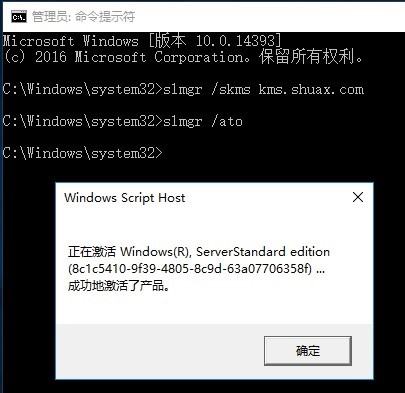
密钥用这个:WC2BQ-8NRM3-FDDYY-2BFGV-KHKQY
激活服务器用图片里的那个
Windows Server 2016 简体中文标准版 实测已激活。
Windows Server 2016 简体中文标准版用微软官网下载的评估版升级成正式版得到
先装官网下载的简体中文评估版,安装好以后用下面这条命令升级,其他版本还没试过,标准版已经成功。
DISM /online /Set-Edition:serverstandard /ProductKey:WC2BQ-8NRM3-FDDYY-2BFGV-KHKQY /AcceptEula
数据中心版用下面这条命令也可把评估版升级正式版,激活方法同上,实测成功
DISM /online /Set-Edition:serverdatacenter /ProductKey:CB7KF-BWN84-R7R2Y-793K2-8XDDG /AcceptEula
参考技术A 说明激活不成功,需要重新激活。一、在线密钥激活:1、首先先介绍下密钥激活的方法, 在桌面找到“计算机”图标,点右键,选择“属性”。
2、在计算机属性页的最下方有激活信息,如果没有激活,请点击这个激活链接:今天激活,立即激活windows。
3、然后在接下来的页面中输入win7系统密钥(这是购买win7系统时候所带的正版密钥),输入完成,点击下一步。
4、激活过程将需要一些时间 ,如果激活成功,则会在最后有提示,如果不成功,会出现另一个界面,提示选择用别的方式来激活系统。
二、软件工具激活:
1、下面开始介绍软件激活win7的方法,激活之前先要准备好激活工具,也就是激活软件。
2、下载完成后,解压win7激活工具。
3、以管理员的身份运行win7激活工具。选中解压后的激活工具,右键菜单栏,选择“以管理员身份运行”(记住,一定要使用以管理员身份运行,否则,可能会失败)。
4、win7激活工具运行界面,点“确定”进行下一步。
5、输入“1”按回车键即可开始自动安装。自动安装会需要几分钟时间,请耐心等待。
6、激活成功,会出现对话框,点击“确认”完成win7激活。追问
这是Win server2016不是你所谓的Win7,谢谢。请看清楚问题,不要随便复制粘贴,如果你意识到自己的回答有误,请自觉删除,以免误导小白。
参考技术B Server2016可以用KMS激活。要用新版的,百度找或者http://www.mcxiaofan.cn/soft_43.html我收集的。KMS是半年激活一次,不卸载kms可以自动激活,能激活Windows8-win10-server2012-server2016全部版本。至少我到现在还没找到能用的永久激活工具。 参考技术C 用激活工具很简单啊,再有,你之前如果是2012/2008已经激活的,在它们下面再安装2016,完成后也是自动激活的
Upgrade Windows Server 2016 to Windows Server 2019
Pre-Upgrade
Upgrade path:
Windows Server 2016 can be upgraded to Windows 2019 in a single upgrade process.
Support:
In-place Upgrade is supported for Windows Server 2016 on physicaL hardware, and in Virtual Machines. Public and private cloud companies also support In-place Upgrade on Windows Server 2016 Virtual Machines to upgrade to Windows Server 2019 – check with your cloud provider.
Alternative:
Migrate (re-deploy) applications and data on a clean install of Windows Server 2019.
Limitations:
- For the smoothest upgrade experience, if you‘ve deployed software-defined datacenter (SDDC) features like Software-Defined Networking (SDN) or Storage Spaces Direct, you are encouraged to wait for validated hardware from the Windows Server Software-Defined (WSSD) program to become available. The first wave of validated hardware is expected very soon; in mid-January 2019. Until then, please evaluate Windows Server 2019 using the Windows Insider edition, or call Microsoft support for recommendations on how to proceed.
- Windows Servers configured to “Boot from VHD” cannot be upgraded using In-place Upgrade.
Planning for In-place Upgrade
Before proceeding with In-place Upgrade, collect the following information:
-
Is there a target or goal timeframe for upgrading this server?
-
Is this a production-critical server?
-
Is there a maintenance window for upgrading this server?
-
Is there enough time for a test upgrade on an identical or similar non-production server?
-
Who uses this server? Internal users, external users, or both? Have they been informed of the upgrade or maintenance?
-
Is there an inventory of what is running on the server? Check the following:
-
Windows Server Roles and Features
-
Microsoft applications: SQL Server, SharePoint Server, Exchange Server, etc.
-
3rd-Party applications: SAP, Oracle, DB2, etc.
-
Is the server joined to an Active Directory domain?
-
Are any of the server disks BitLocker protected?
-
Is the server part of a Failover Cluster?
Note that Cluster OS Rolling Upgrade can be used to upgrade Windows Server 2016 Failover Clusters to Windows Server 2019.
-
-
How often is the server backed-up? Have backups ever been successfully restored (applied) to the server or applications?
-
What backup software is used?
-
If In-place Upgrade is not successful and the server needs to be rebuilt, are the Windows Server and application install media available?
Although it is rare, In-place Upgrade can fail and there should be a plan in-place for this possibility, to minimize server downtime and maintain SLAs.
-
Is the server fully patched? It is strongly recommended that the server is fully patched prior to In-place Upgrade.
-
Run systeminfo.exe and save the output:
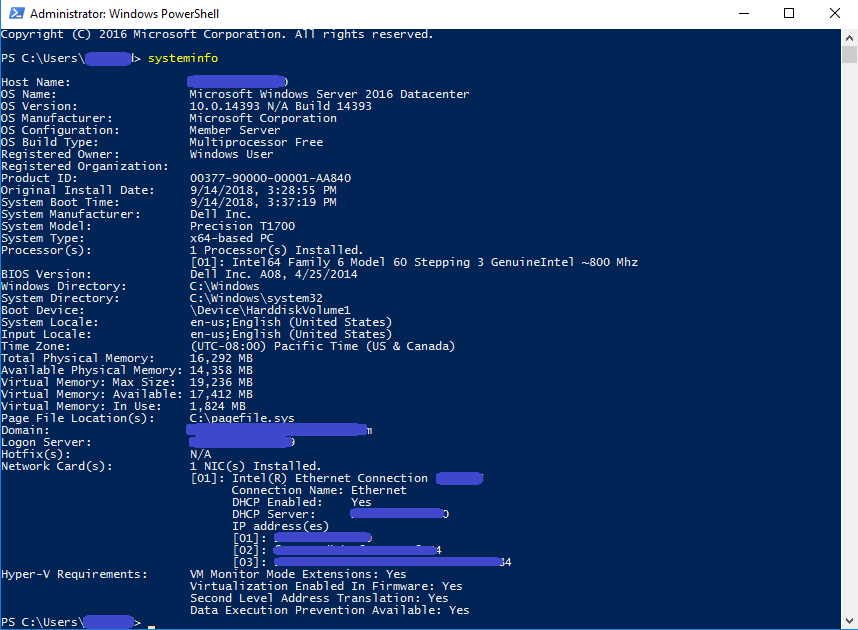
-
Run ipconfig /all and save the output:
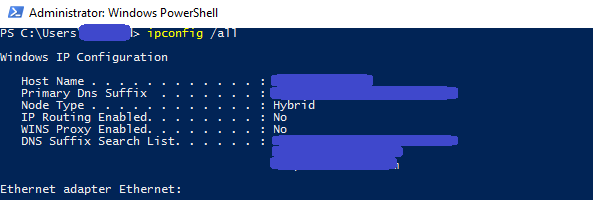
-
Run Get-WindowsFeature and save the output:

-
Run RegEdit and capture the value of the the HKEY_LOCAL_MACHINESOFTWAREMicrosoftWindowsNTCurrentVersion hive – this will show the exact version (BuildLabEx) and edition (EditionID) of Windows Server:
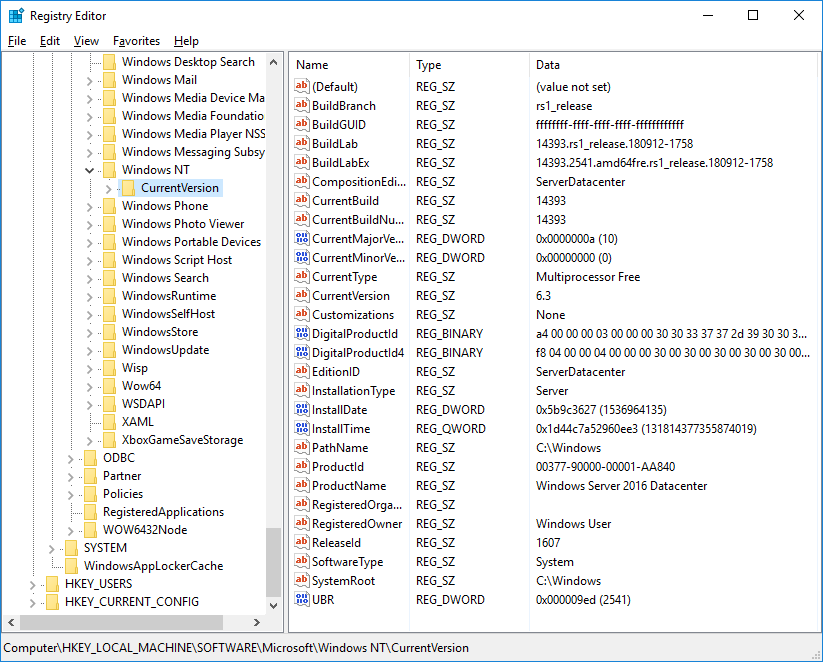
Before proceeding with the In-place Upgrade
-
Backup the Operating System, Applications, and Virtual Machines.
-
Shutdown, Quick Migrate, or Live Migrate all Virtual Machines running on the server - Virtual Machines cannot be running on the server during In-place Upgrade.
Upgrade
-
Locate the setup media for Windows Server 2019
-
Run setup.exe by double-clicking it:
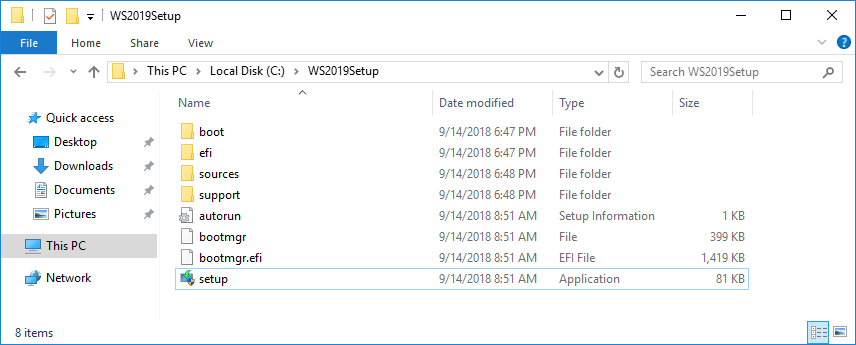
-
Click Yes to enable setup to proceed:
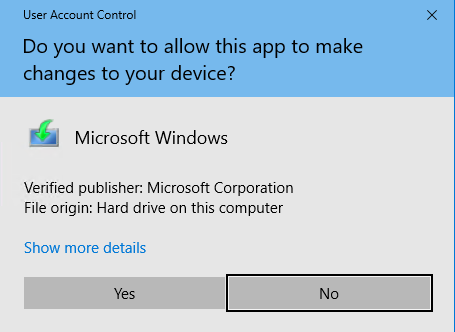
-
For internet-connected devices, we recommend the Download updates, drivers and optional features option. Click Next:
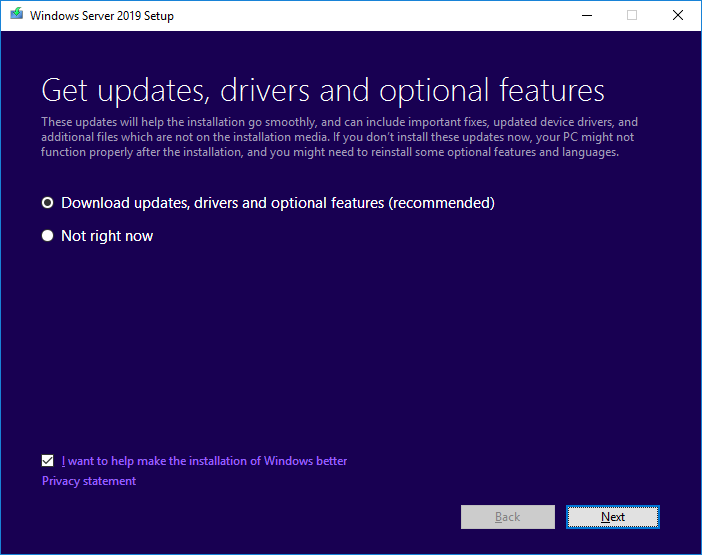
-
Setup will check the configuration of your computer – please wait:

-
Depending on the distribution channel that you received Windows Server media from (Retail, Volume License, OEM, ODM, etc.) and the license for the server, you may be prompted to enter a licensing key to proceed.
-
You will be prompted to select the image of the Edition to upgrade to. Then click Next:
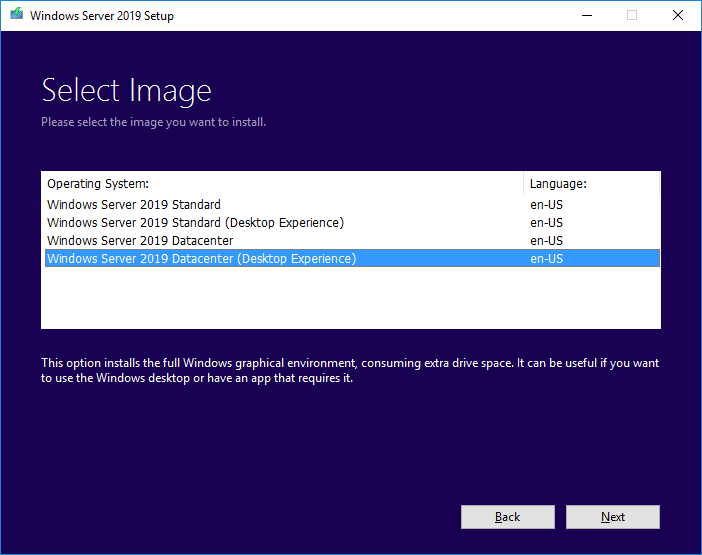
-
Depending on the distribution channel that you received Windows Server media from (Retail, Volume License, OEM, ODM, etc.) you may be presented with different license agreements. Click Accept:
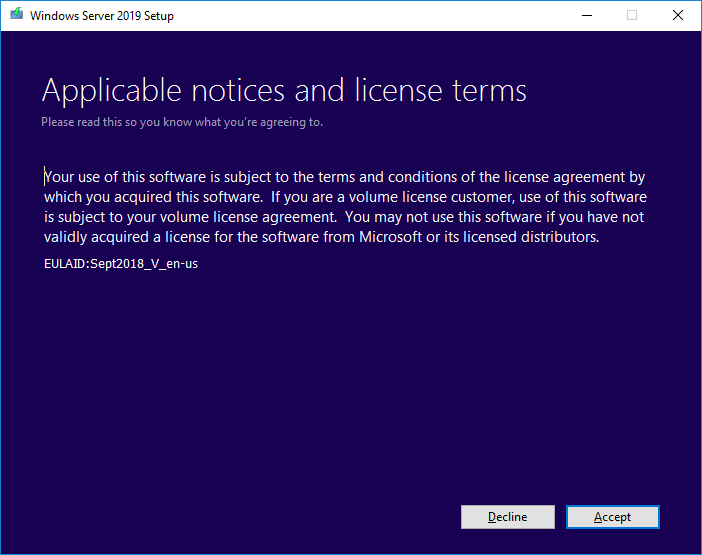
-
For In-place Upgrade, select Keep personal files and apps, and then click Next:
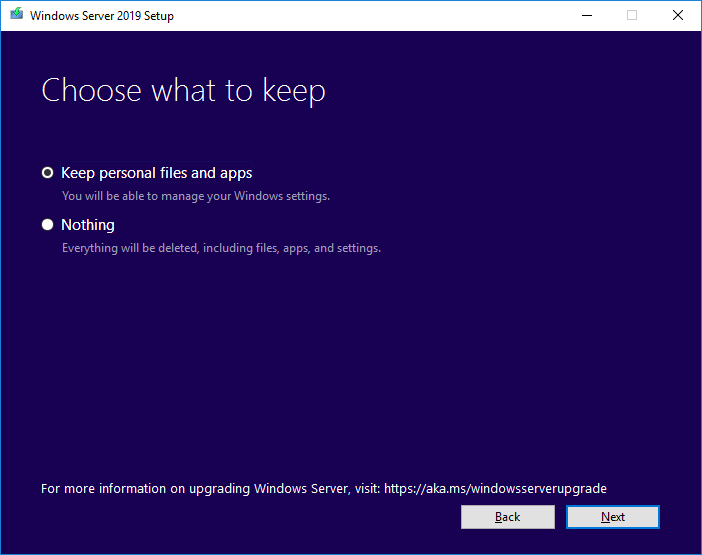
-
When the analysis phase is complete, setup will prompt you to click Back to change choices, or to proceed with the In-place Upgrade. Click Install:
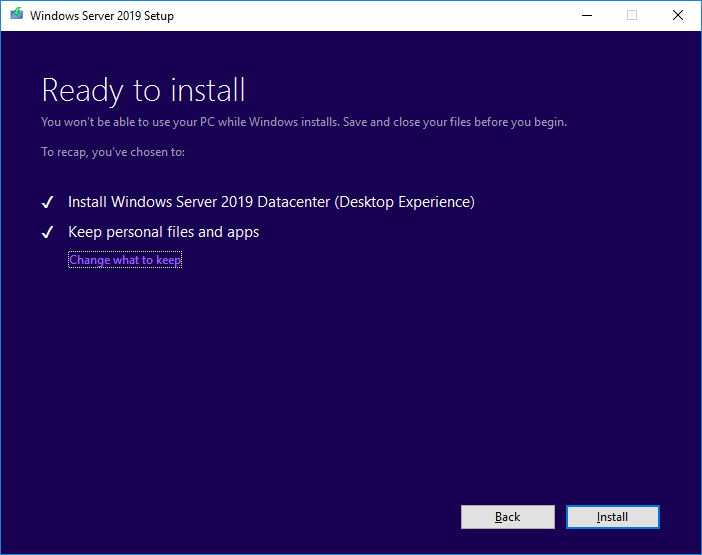
-
Setup will proceed with the In-place Upgrade, and then the server will reboot:
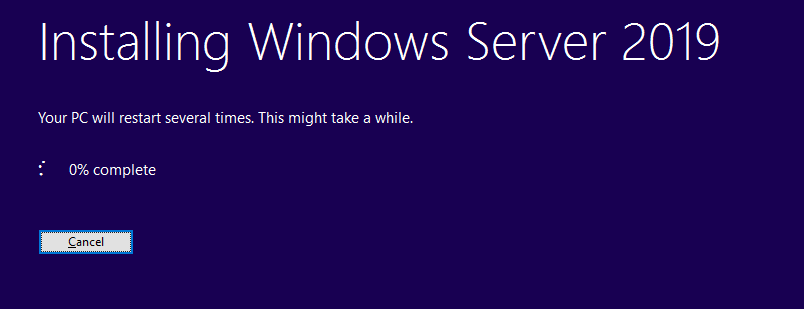
- Setup will complete and the server will reboot.
Post-upgrade
-
After Setup has completed installing and rebooted the sever, login to check that the server has been successfully upgraded. If you selected Windows Server 2019 Standard or Datacenter Desktop Edition, you should see the Server Manager window:
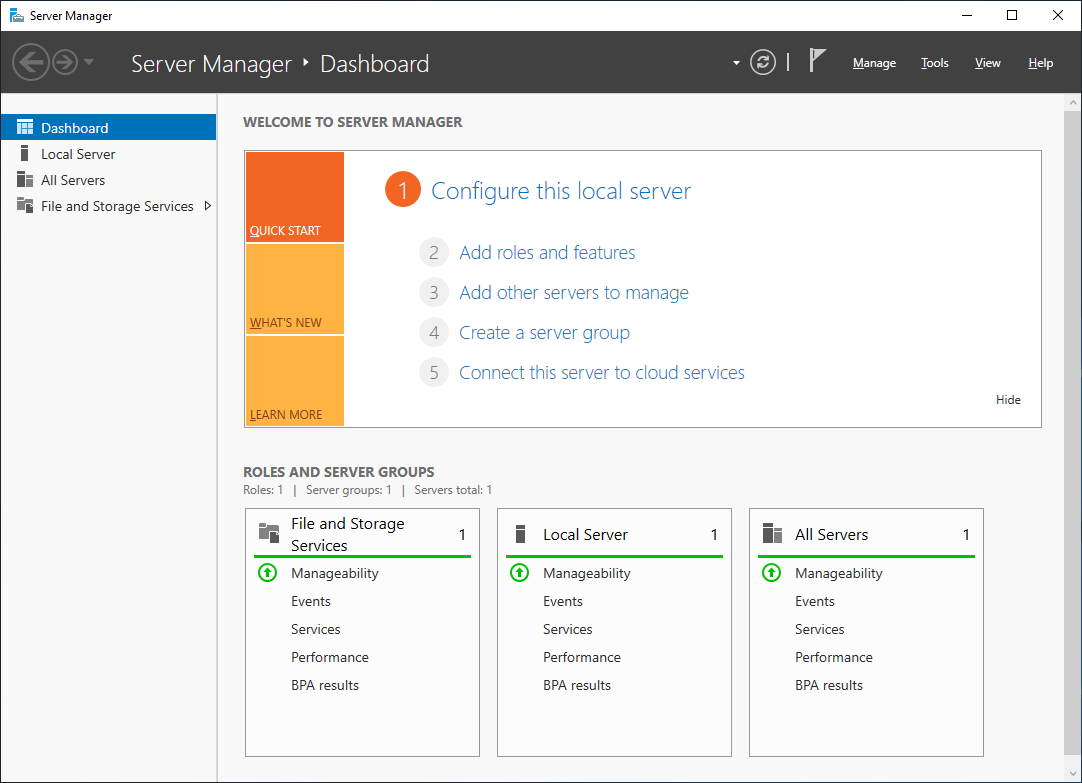
-
Run RegEdit and check the value of the HKEY_LOCAL_MACHINESOFTWAREMicrosoftWindowsNTCurrentVersion hive – the version should be successfully updated to Windows Server 2019.
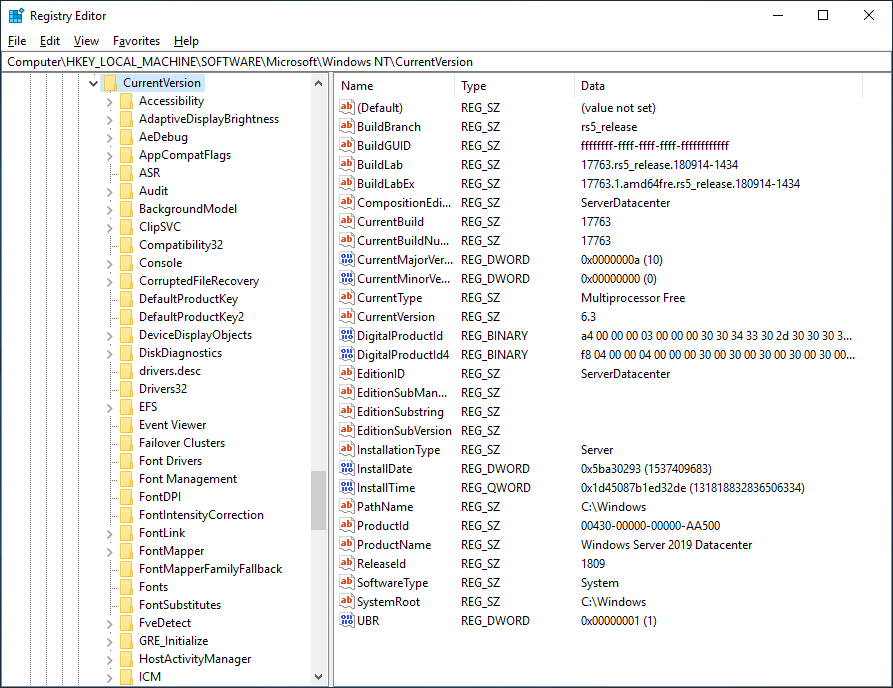
-
Check that applications are running and that client connections to the applications succeed.
-
If you believe that there has been an issue upgrading you server, you should copy and Zip the %SystemRoot%Panther (usually C:WindowsPanther) directory and contact support.
以上是关于Windows server 2016如何激活? 试过各种激活工具都无效,网上的秘钥输入后的主要内容,如果未能解决你的问题,请参考以下文章
windows server 2016/2019 kms 激活
MCSA / Windows Server 2016 授权许可和MAK / KMS / ADBA激活